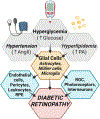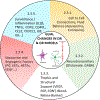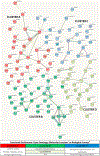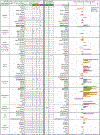Elucidating glial responses to products of diabetes-associated systemic dyshomeostasis
- PMID: 37028118
- PMCID: PMC10683564
- DOI: 10.1016/j.preteyeres.2022.101151
Elucidating glial responses to products of diabetes-associated systemic dyshomeostasis
Abstract
Diabetic retinopathy (DR) is a leading cause of blindness in working age adults. DR has non-proliferative stages, characterized in part by retinal neuroinflammation and ischemia, and proliferative stages, characterized by retinal angiogenesis. Several systemic factors, including poor glycemic control, hypertension, and hyperlipidemia, increase the risk of DR progression to vision-threatening stages. Identification of cellular or molecular targets in early DR events could allow more prompt interventions pre-empting DR progression to vision-threatening stages. Glia mediate homeostasis and repair. They contribute to immune surveillance and defense, cytokine and growth factor production and secretion, ion and neurotransmitter balance, neuroprotection, and, potentially, regeneration. Therefore, it is likely that glia orchestrate events throughout the development and progression of retinopathy. Understanding glial responses to products of diabetes-associated systemic dyshomeostasis may reveal novel insights into the pathophysiology of DR and guide the development of novel therapies for this potentially blinding condition. In this article, first, we review normal glial functions and their putative roles in the development of DR. We then describe glial transcriptome alterations in response to systemic circulating factors that are upregulated in patients with diabetes and diabetes-related comorbidities; namely glucose in hyperglycemia, angiotensin II in hypertension, and the free fatty acid palmitic acid in hyperlipidemia. Finally, we discuss potential benefits and challenges associated with studying glia as targets of DR therapeutic interventions. In vitro stimulation of glia with glucose, angiotensin II and palmitic acid suggests that: 1) astrocytes may be more responsive than other glia to these products of systemic dyshomeostasis; 2) the effects of hyperglycemia on glia are likely to be largely osmotic; 3) fatty acid accumulation may compound DR pathophysiology by promoting predominantly proinflammatory and proangiogenic transcriptional alterations of macro and microglia; and 4) cell-targeted therapies may offer safer and more effective avenues for DR treatment as they may circumvent the complication of pleiotropism in retinal cell responses. Although several molecules previously implicated in DR pathophysiology are validated in this review, some less explored molecules emerge as potential therapeutic targets. Whereas much is known regarding glial cell activation, future studies characterizing the role of glia in DR and how their activation is regulated and sustained (independently or as part of retinal cell networks) may help elucidate mechanisms of DR pathogenesis and identify novel drug targets for this blinding disease.
Keywords: Angiogenesis; Diabetic retinopathy; Dysregulation; Homeostasis; Hyperglycemia; Hyperlipidemia; Hypertension; Inflammation; Retinal glia; Visual impairment.
Copyright © 2022 The Authors. Published by Elsevier Ltd.. All rights reserved.
Conflict of interest statement
Disclosures
None.
Figures











Similar articles
-
Neurovascular cross talk in diabetic retinopathy: Pathophysiological roles and therapeutic implications.Am J Physiol Heart Circ Physiol. 2016 Sep 1;311(3):H738-49. doi: 10.1152/ajpheart.00005.2016. Epub 2016 Jul 29. Am J Physiol Heart Circ Physiol. 2016. PMID: 27473938 Free PMC article. Review.
-
Prognostic factors for the development and progression of proliferative diabetic retinopathy in people with diabetic retinopathy.Cochrane Database Syst Rev. 2023 Feb 22;2(2):CD013775. doi: 10.1002/14651858.CD013775.pub2. Cochrane Database Syst Rev. 2023. PMID: 36815723 Free PMC article. Review.
-
The role of lipopolysaccharides in diabetic retinopathy.BMC Ophthalmol. 2022 Feb 22;22(1):86. doi: 10.1186/s12886-022-02296-z. BMC Ophthalmol. 2022. PMID: 35193549 Free PMC article. Review.
-
The importance of glial cells in the homeostasis of the retinal microenvironment and their pivotal role in the course of diabetic retinopathy.Life Sci. 2016 Oct 1;162:54-9. doi: 10.1016/j.lfs.2016.08.001. Epub 2016 Aug 3. Life Sci. 2016. PMID: 27497914 Review.
-
Role of Inflammation in Diabetic Retinopathy.Int J Mol Sci. 2018 Mar 22;19(4):942. doi: 10.3390/ijms19040942. Int J Mol Sci. 2018. PMID: 29565290 Free PMC article. Review.
Cited by
-
Single-cell RNA sequencing in exploring the pathogenesis of diabetic retinopathy.Clin Transl Med. 2024 Jul;14(7):e1751. doi: 10.1002/ctm2.1751. Clin Transl Med. 2024. PMID: 38946005 Free PMC article. Review.
-
Induction, amplification, and propagation of diabetic retinopathy-associated inflammatory cytokines between human retinal microvascular endothelial and Müller cells and in the mouse retina.Cell Signal. 2024 Dec;124:111454. doi: 10.1016/j.cellsig.2024.111454. Epub 2024 Oct 9. Cell Signal. 2024. PMID: 39384004 Free PMC article.
-
The Role of Non-coding RNAs in Diabetic Retinopathy: Mechanistic Insights and Therapeutic Potential.Mol Neurobiol. 2025 Aug;62(8):9829-9860. doi: 10.1007/s12035-025-04863-z. Epub 2025 Apr 1. Mol Neurobiol. 2025. PMID: 40164888 Review.
-
Alzheimer's disease as a causal risk factor for diabetic retinopathy: a Mendelian randomization study.Front Endocrinol (Lausanne). 2024 Apr 18;15:1340608. doi: 10.3389/fendo.2024.1340608. eCollection 2024. Front Endocrinol (Lausanne). 2024. PMID: 38699385 Free PMC article.
-
Prostanoid signaling in retinal cells elicits inflammatory responses relevant to early-stage diabetic retinopathy.J Neuroinflammation. 2024 Dec 23;21(1):329. doi: 10.1186/s12974-024-03319-w. J Neuroinflammation. 2024. PMID: 39716241 Free PMC article.
References
-
- Abu El-Asrar AM, Ahmad A, Allegaert E, Siddiquei MM, Gikandi PW, De Hertogh G, Opdenakker G, 2020. Interleukin-11 overexpression and M2 macrophage density are associated with angiogenic activity in proliferative diabetic retinopathy. Ocul. Immunol. Inflamm 28, 575–588. - PubMed
-
- Abu El-Asrar AM, Alam K, Nawaz MI, Mohammad G, Van den Eynde K, Siddiquei MM, Mousa A, De Hertogh G, Opdenakker G, 2016. Upregulation of thrombin/matrix metalloproteinase-1/protease-activated receptor-1 chain in proliferative diabetic retinopathy. Curr. Eye Res 41, 1590–1600. - PubMed
Publication types
MeSH terms
Substances
Grants and funding
LinkOut - more resources
Full Text Sources
Medical

